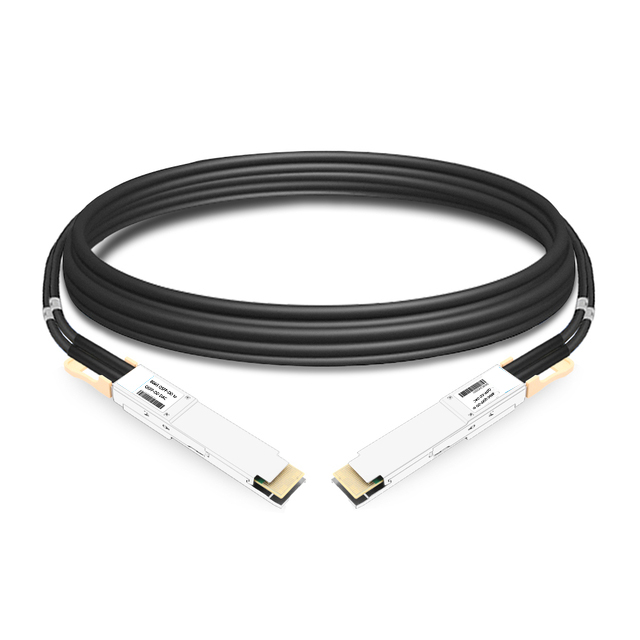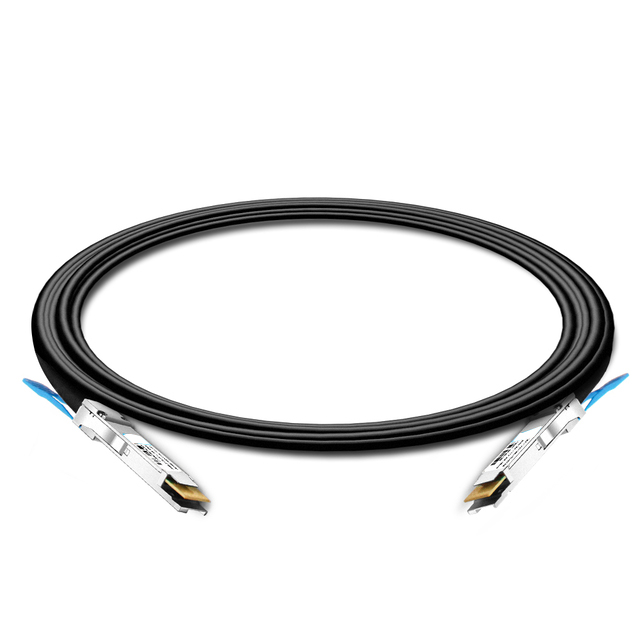What is a DAC Cable?
In modern data centers and enterprise networks, Direct Attach Copper (DAC) cables are a cost-effective and efficient solution for short-distance interconnections between devices like switches, servers, and storage units. These cables integrate transceivers directly into the cable assembly, eliminating the need for separate optical modules.

What Is a DAC Cable?
A DAC cable is a pre-terminated twinax copper cable with fixed connectors on both ends, designed to connect networking devices directly. They are commonly used in applications requiring high-speed data transmission over short distances, typically up to 15 meters. As a cost-effective alternative to optical fiber, Direct Attach Copper cables are especially favored for their low cost and low power consumption.
How to Classify DAC Cables?
DAC cables can be categorized based on various factors:
1. By Signal Conditioning
-
Passive DAC Cables: These cables contain no active components and rely solely on the copper wire for signal transmission. They are suitable for shorter distances and consume less power.
-
Active DAC Cables: Incorporate electronic components like signal amplifiers to boost signal strength, allowing for longer transmission distances with improved signal integrity.
2. By Connector Type
-
SFP+ to SFP+: Commonly used for 10 Gigabit Ethernet connections.
-
QSFP+ to QSFP+: Designed for 40 Gigabit Ethernet applications.
-
QSFP28 to QSFP28: Supports 100 Gigabit Ethernet standards.
-
QSFP+ to SFP+ Breakout: Allows one 40G port to connect to four 10G ports.
3. By Cable Structure
-
Standard DAC Cables: Consist of a single cable with connectors on both ends.
-
Breakout DAC Cables: Feature one connector on one end and multiple connectors on the other, enabling connections to multiple devices from a single port.
4. By Data Rate
-
10G DAC Cables: Support 10 Gigabit Ethernet speeds.
-
25G DAC Cables: Designed for 25 Gigabit Ethernet applications.
-
40G DAC Cables: Used for 40 Gigabit Ethernet connections.
-
100G DAC Cables: Support 100 Gigabit Ethernet standards.

DAC vs. Fiber Optic Cables
| Feature | DAC Cable | Fiber Optic Cable |
|---|---|---|
| Transmission Distance | Up to 15 meters | Up to several kilometers |
| Power Consumption | Low (especially passive) | Higher due to active components |
| Cost | Lower | Higher |
| Latency | Lower | Higher |
| Durability | More susceptible to EMI | Immune to EMI |
| Flexibility | Less flexible | More flexible |
| Use Case | Short-distance connections | Long-distance connections |
Common Applications of DAC Cables
-
Top-of-Rack (ToR) Connections: Connecting servers to switches within the same rack.
-
Rack-to-Rack Interconnections: Linking devices across adjacent racks.
-
High-Performance Computing (HPC) Clusters: Providing low-latency connections between compute nodes.
-
Storage Area Networks (SANs): Connecting storage devices to servers.
Advantages of DAC Cables
-
Cost-Effective: Eliminates the need for separate optical transceivers, making DAC cables a more affordable option than fiber optic cables.
-
Low Latency: Provides faster data transmission compared to some fiber optic solutions, especially in shorter-distance applications.
-
Energy Efficient: Consumes less power, especially passive variants.
-
Ease of Installation: Simplifies setup with pre-terminated cables, reducing installation time.
Limitations of DAC Cables
-
Limited Transmission Distance: Not suitable for long-distance connections, typically capped at 15 meters for most applications.
-
Susceptibility to Electromagnetic Interference (EMI): Copper-based cables are more vulnerable to EMI, which can degrade signal quality.
-
Less Flexibility: Fixed lengths may not suit all installation scenarios, making customization more difficult.
Choosing the Right DAC Cable
When selecting a DAC cable, consider the following:
-
Distance Requirements: Choose active cables for longer distances, and passive cables for shorter applications.
-
Data Rate Needs: Ensure the cable supports the required data rate for your networking needs.
-
Connector Compatibility: Match the cable connectors with your devices to ensure seamless integration.
-
Budget Constraints: Balance cost with performance requirements. DAC cables are generally more affordable than fiber optic cables, making them a great option for budget-conscious deployments.
Brand Spotlight: Fibrecross
Fibrecross offers a range of high-quality Direct Attach Copper cables suitable for various networking needs. Known for their reliability and high performance, Fibrecross DAC cables are ideal for use in data centers and enterprise networks, where both speed and cost-effectiveness are essential.
Understanding the classification and applications of DAC cables can help in selecting the appropriate solution for your networking requirements. Whether you’re setting up a new data center or upgrading existing infrastructure, Direct Attach Copper cables provide a practical and efficient option for short-distance connections, especially when combined with high-speed data transfer needs.



